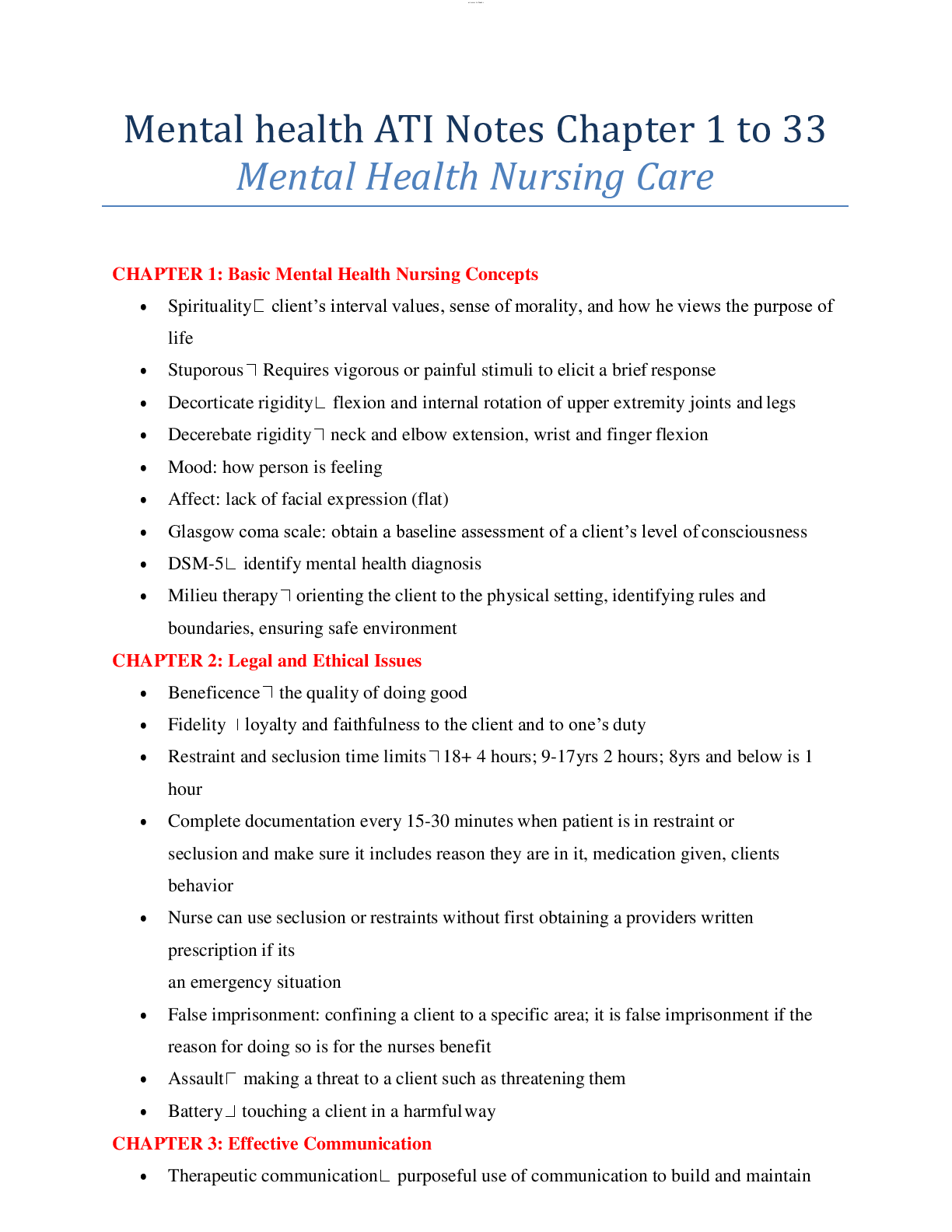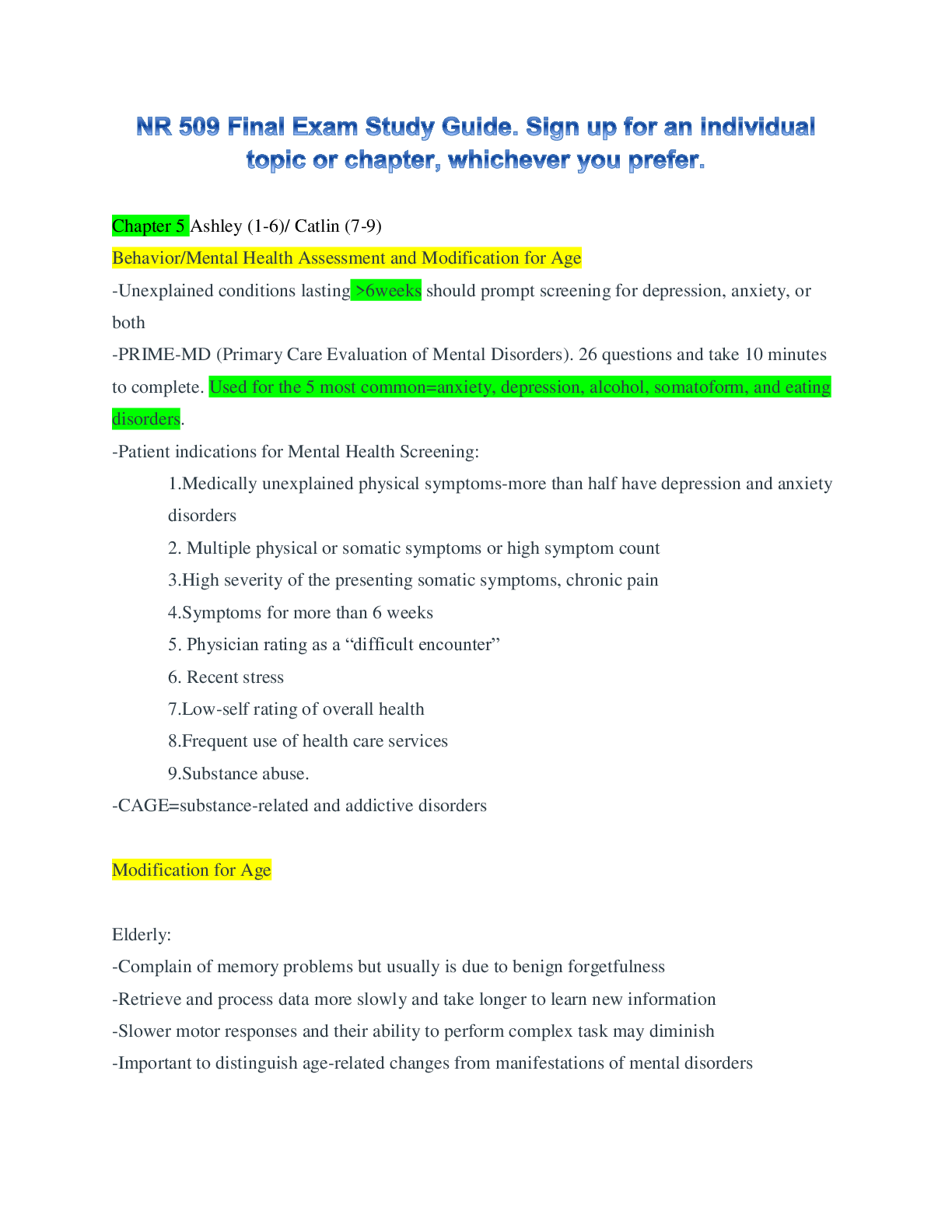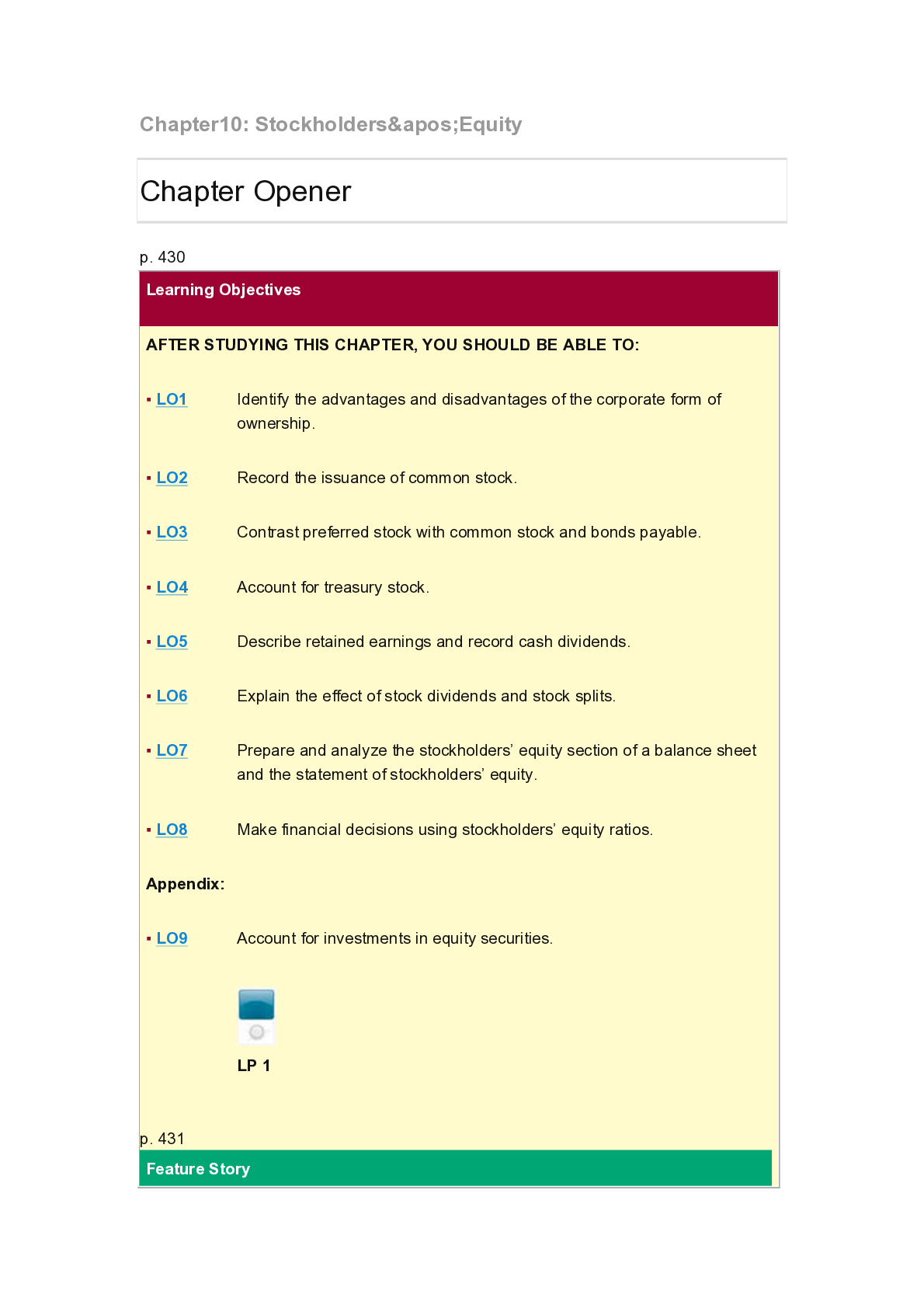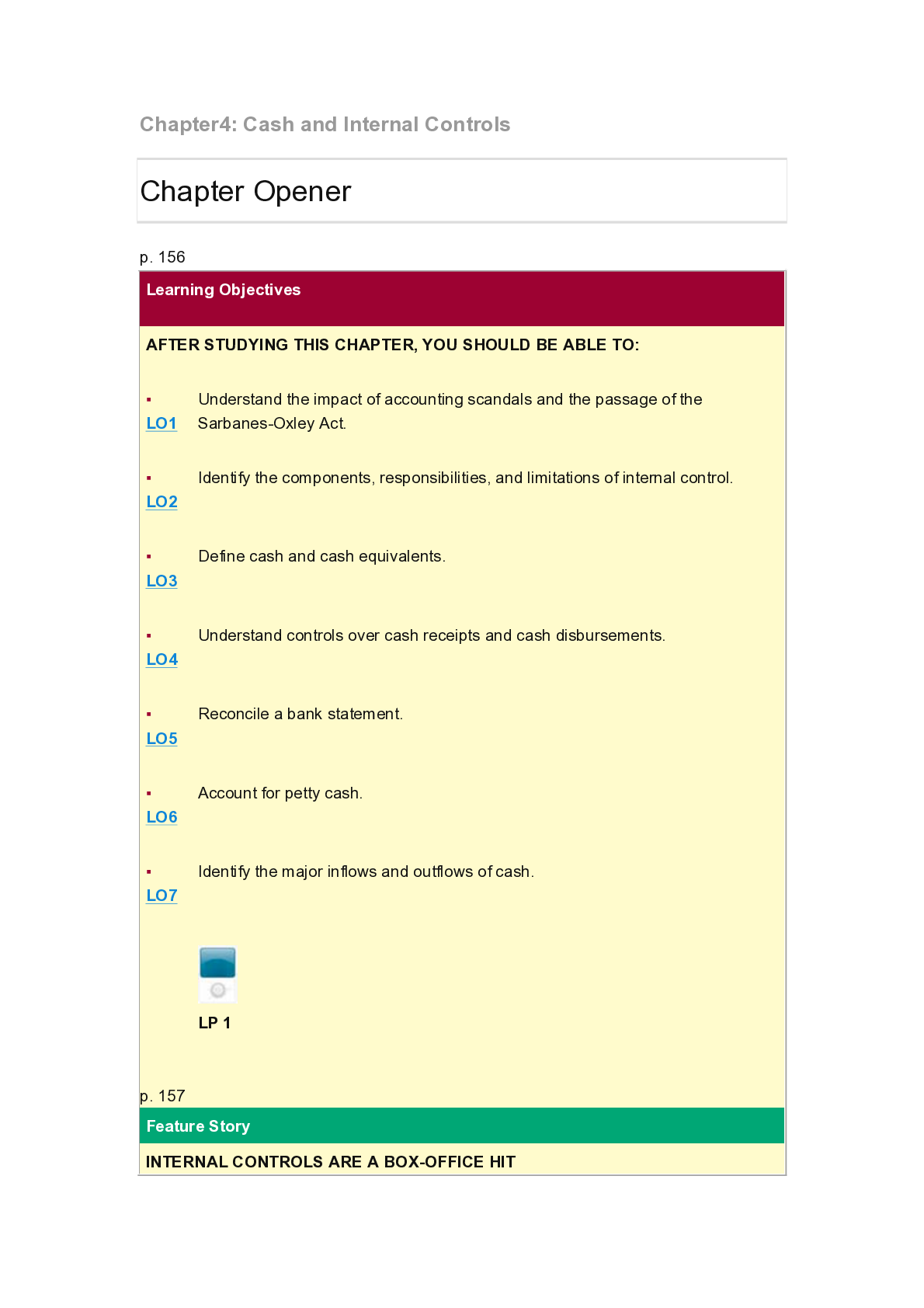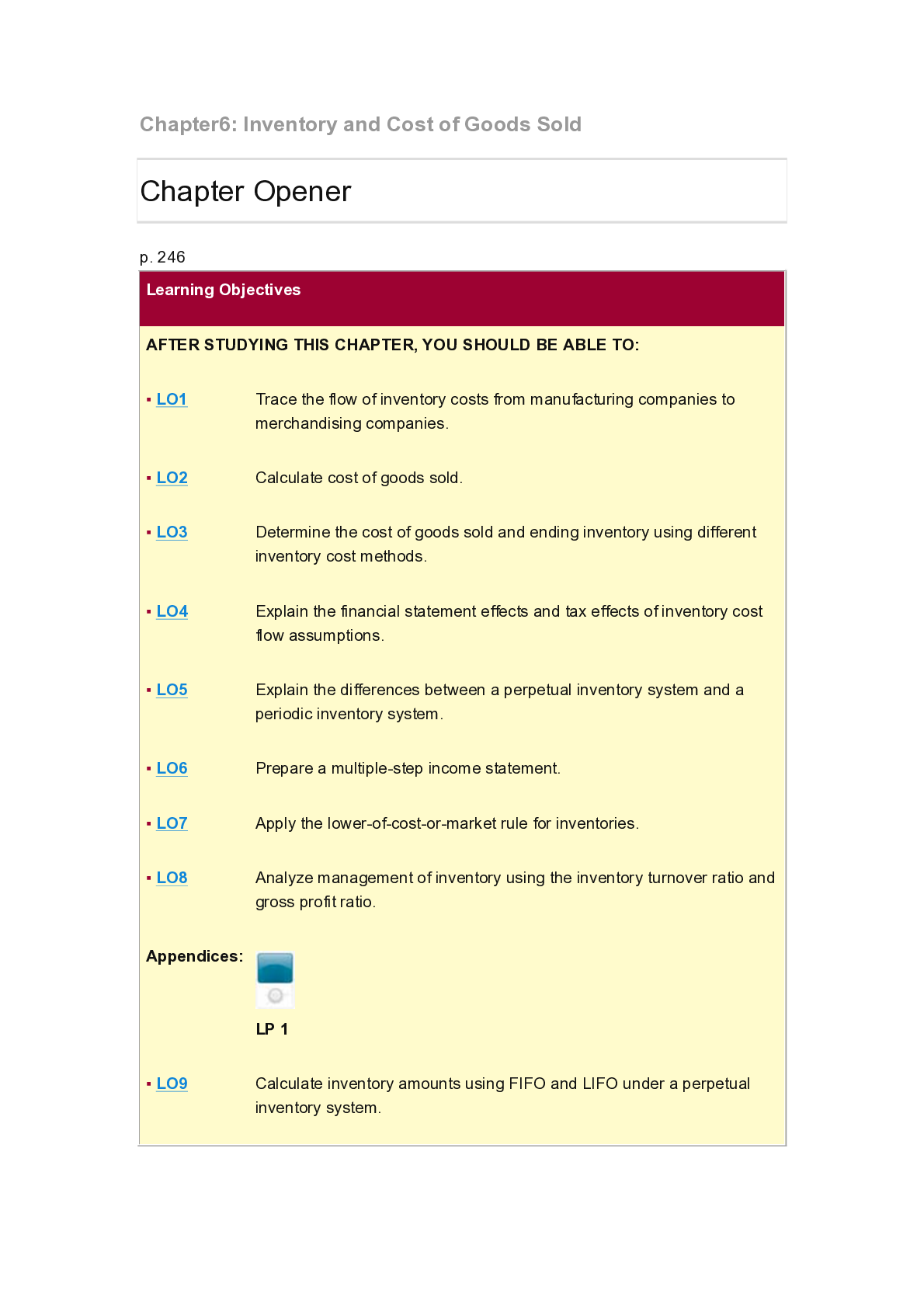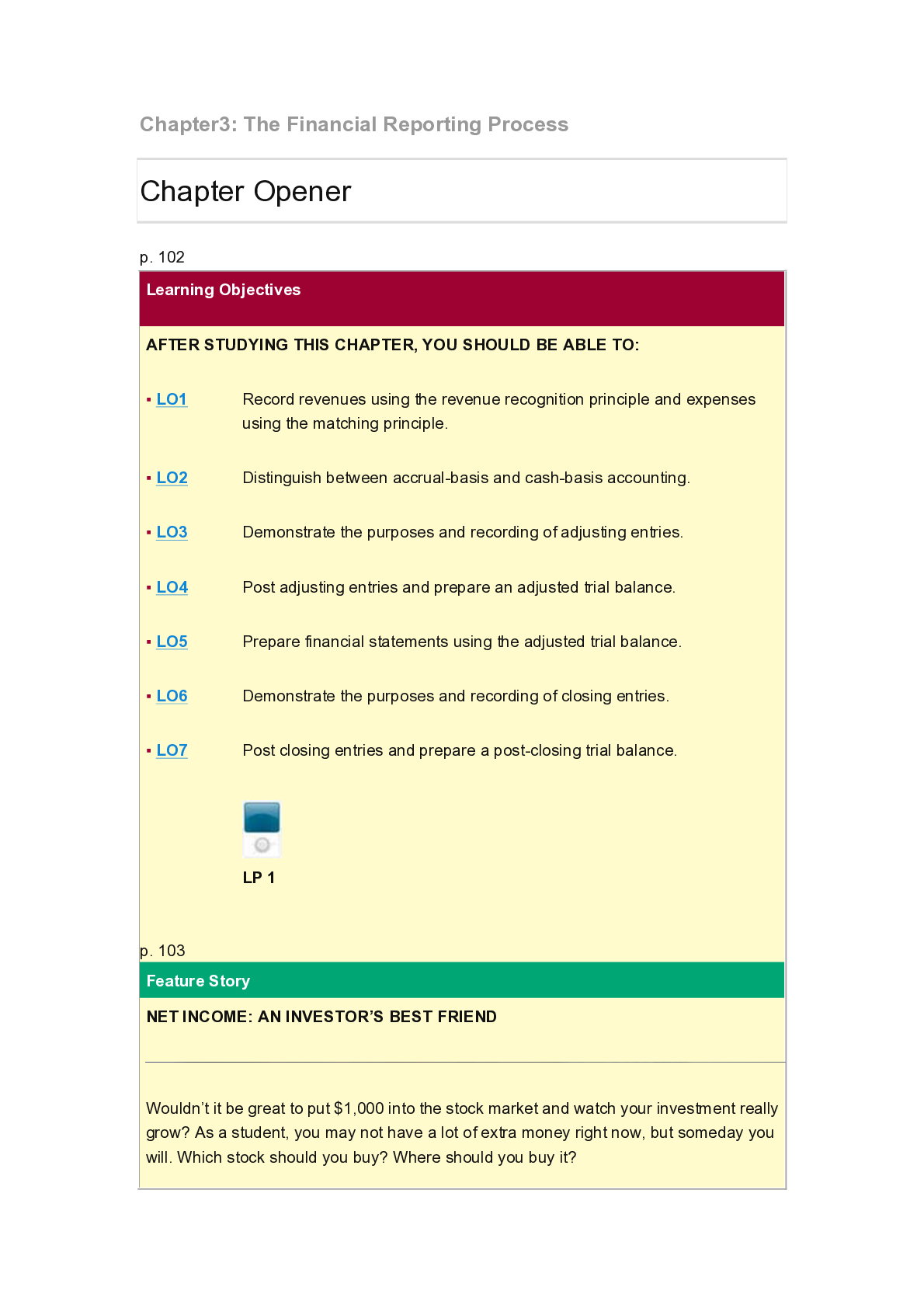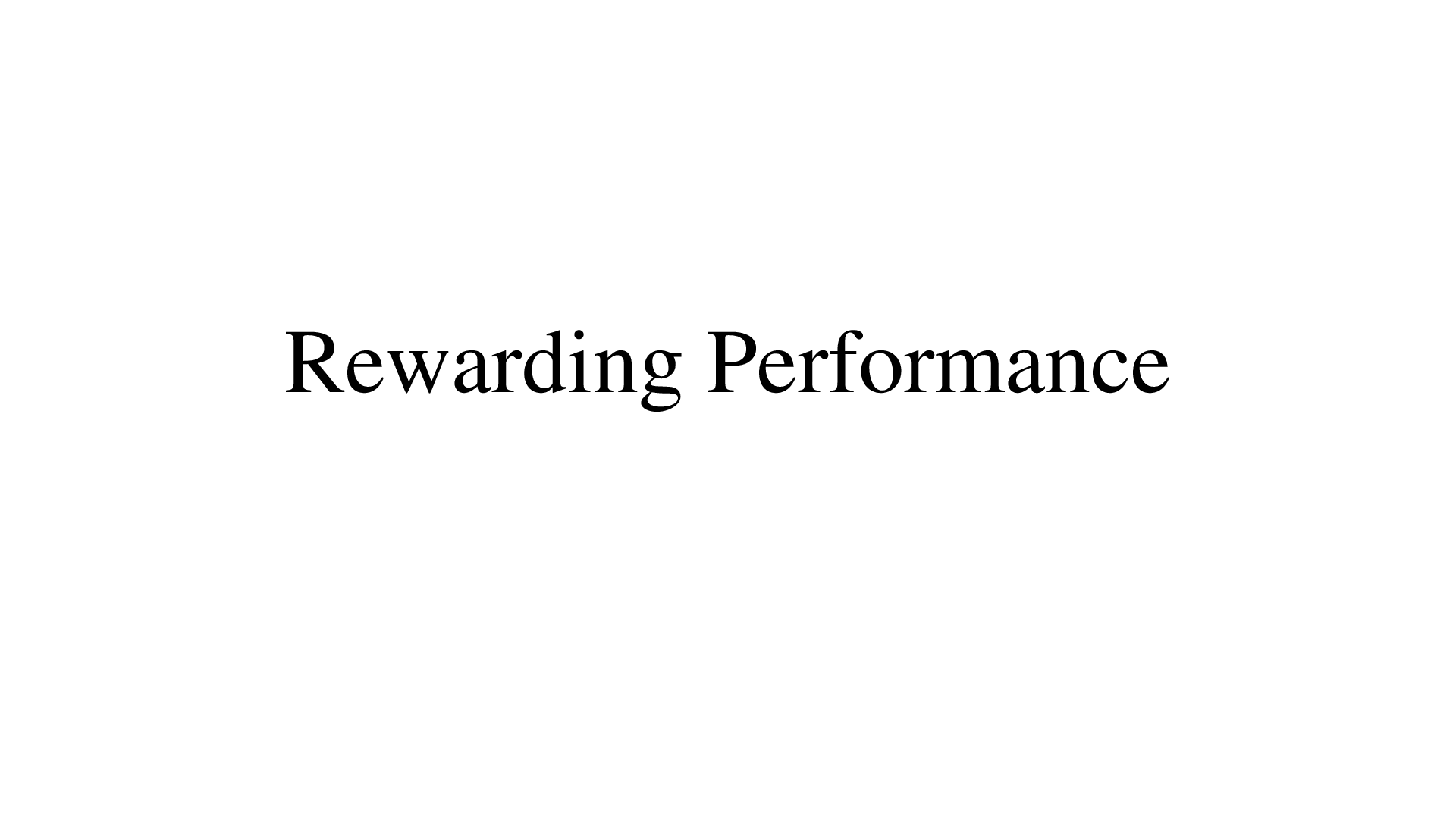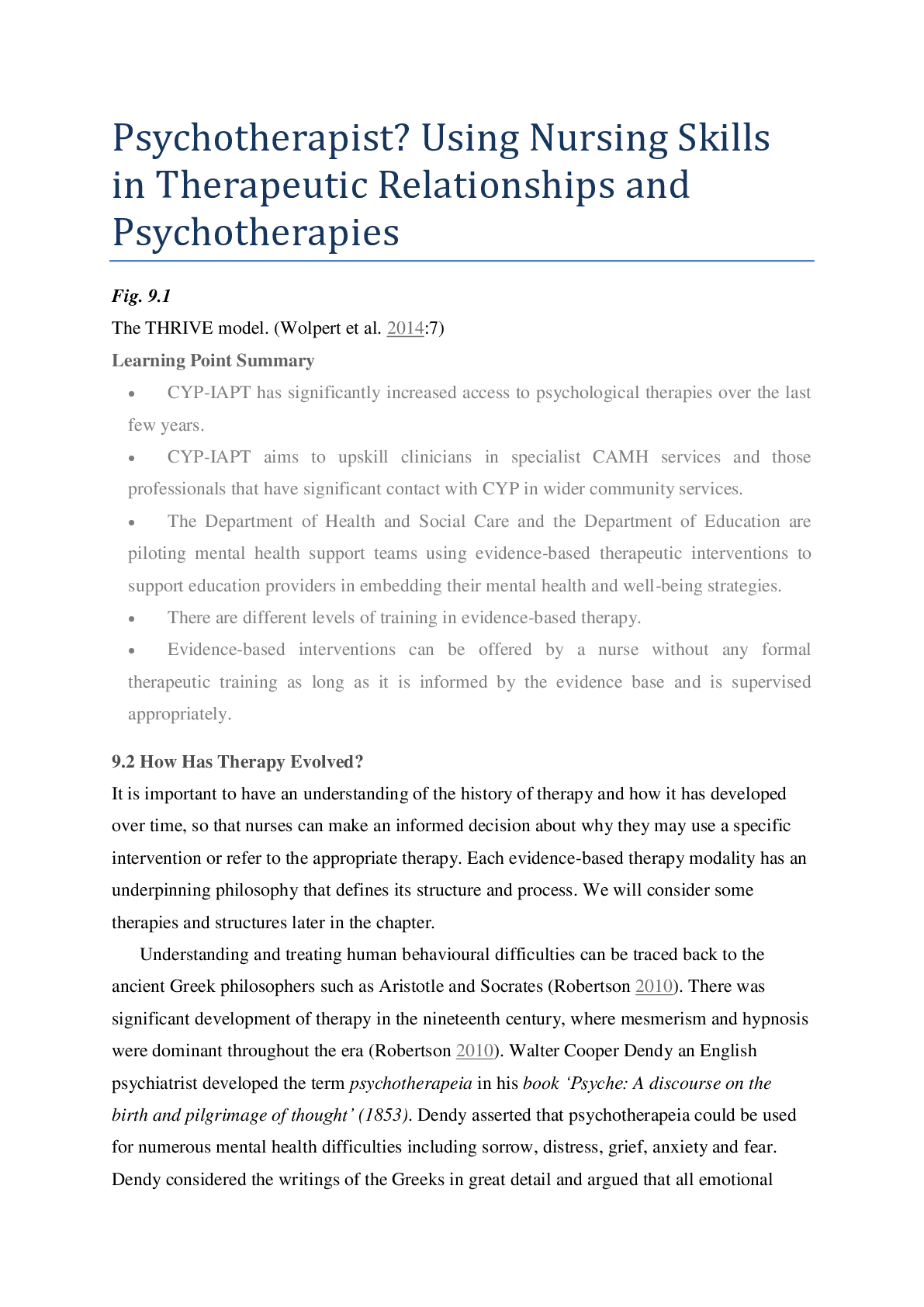*NURSING > Study Notes > Psychotherapist? Using Nursing Skills in Therapeutic Relationships and Psychotherapies (All)
Psychotherapist? Using Nursing Skills in Therapeutic Relationships and Psychotherapies
Document Content and Description Below
Learning Point Summary • CYP-IAPT has significantly increased access to psychological therapies over the last few years. • CYP-IAPT aims to upskill clinicians in specialist CAMH services and tho... se professionals that have significant contact with CYP in wider community services. • The Department of Health and Social Care and the Department of Education are piloting mental health support teams using evidence-based therapeutic interventions to support education providers in embedding their mental health and well-being strategies. • There are different levels of training in evidence-based therapy. • Evidence-based interventions can be offered by a nurse without any formal therapeutic training as long as it is informed by the evidence base and is supervised appropriately. 9.2 How Has Therapy Evolved? Learning Point Summary • Psychotherapy or helping people deal with psychological difficulties can be traced back to the ancient Greeks. • There are many different models of therapy. • Therapy is always developing. • It is really important to ensure the therapy is the right fit for the CYP and not the CYP be fitted for the therapy. • NICE (2019) offers guidance about what therapies are demonstrated to be effective for specific diagnoses. • Trained therapists can help you choose an appropriate therapy or intervention for a patient. 9.3 An Overview of Some of the Therapies 9.3.1 Cognitive Behavioural Therapy Learning Point Summary • CBT is a structured approach to therapy; the model will not suit CYPs who do not want to work in between sessions and do not want to challenge their difficulties. • CBT is very collaborative and holds the collaboration as central to its philosophy, the therapist and CYP are equal in the therapeutic relationship. • CBT is not just about changing thoughts and CYPs should not be referred for this alone. • It is a short-term evidence-based treatment for a range of mental health difficulties. • CBT works to an agenda and goal-based outcomes and uses ROMS throughout its process. 9.3.2 Psychodynamic Therapy Learning Point Summary • Psychodynamic therapy is a medium-term intervention that focuses on relationships. • It is evidence-based for depression and eating disorders. • Psychodynamic theory uses object relational theory to help understand relationships. • Two key structures within psychodynamic theory are transference and countertransference. • It is usually the CYP and the therapist that attend therapy and no other persons involved. 9.3.3 Systemic Family Therapy Learning Point Summary • SFT is a family-based therapy that involves all necessary members of the family. • It is a medium-term therapy. • SFT is evidence-based for a number of mental health disorders. • SFT is open to using ideas and theories from other models of psychotherapy. • At times reflecting teams are part of the therapy. • SFT holds the therapist in being neutral and valuing all family members as equal. • The therapist has to use self and reflexive use of self to maintain neutrality. 9.3.4 Other Therapies Used in CAMHS 9.4 Some Common Themes Across Therapies 9.4.1 Communication 9.4.2 The Therapeutic Relationship (TR) Supervision Routine Outcome Measures (ROMs) Learning Point Summary • There are many commonalities that cross all psychotherapies. • Being aware of personal values and assumptions are key in all aspects of therapy. • Supervision is a significant part of therapy that needs to be used effectively. • ROMs can be used across the spectrum of therapy and is expected as part of the CYP-IAPT strategy. • Fundamental verbal and non-verbal communication skills are paramount in developing the therapeutic relationship and maintaining therapy. • Nurses are equipped with many of the skills needed to develop and maintain therapy and the therapeutic relationship. References 1. Andersen T (1987) The reflecting team: dialogue and meta-dialogue in clinical work. Fam Pract 26:415–428Crossref 2. Association for Family Therapy (2019) What is family therapy [online]. www.aft.org.uk/consider/view/family-therapy.html. Accessed 31 Jan 2019 3. Beck AT (1967) Depression: the causes and treatment. University of Pennsylvania Press, Philadelphia 4. Bennett-Levy J, Butler G, Fennell M, Hackman A, Mueller M, Westbrook D (2004) Oxford guide to behavioural experiments in cognitive therapy. Oxford University press, OxfordCrossref 5. Berzoff J, Flanagan LM, Hertz P (eds) (2008) Psychodynamic clinical theory and psychopathology in contemporary multi-cultural contexts, 2nd edn. Jason Aronson, Plymouth 6. Brown JAC (1964) Freud and the post-Freudians. Penguin books, Middlesex 7. Brown JM (2010) The Milan principles of hypothesising circularity and neutrality in dialogical family therapy: extinction, evolution, eviction… or emergence? Aust N Z J Fam Ther 31(3):248–265Crossref 8. Burns DD, Auerback A (1996) Therapeutic empathy in cognitive behaviour therapy: does it make a difference? In: Salkovskis PM (ed) Frontiers of cognitive therapy. Guilford Press, New York, pp 135–164 9. Byng-Hall J (1982) Dysfunctions of feeling: experiential life of the family. In: Bentovim A, Barnes GG, Cooklin A (eds) Family therapy: complementary frameworks of theory and practice, vol 1. Academic Press, London, pp 59–78 10. Child and Adolescent Mental Health Services (2008) Children and young people in mind: the final report of the national CAMHS review (the final report) [online]. webarchive.nationalarchives.gov.uk/20081230004520/publications.dcsf.gov.uk/eorderingdownload/camhs-review.pdf. Accessed 20 Dec 2018 11. Colman AM (2003) Oxford dictionary of psychology. Oxford University Press, Oxford 12. CORC (2019a) Child Outcomes Research Consortium [online]. www.corc.uk.net/. Accessed 12 Jan 2019 13. CORC (2019b) Goal based outcomes [online]. www.corc.uk.net/outcome-experience-measures/goal-based-outcomes/. Accessed 12 Jan 2019 14. Dallos R, Draper R (2010) An introduction into family therapy. Systemic theory and practice, 3rd edn. Open University Press, Berkshire 15. Dendy WC (1853) Pscyhe: a discourse on the birth and pilgrimage of thought. Longmans, Browns, Green & Longmans, London 16. Dawson L, Baudinet J, Tay E, Wallis A (2018) Creating community—the introduction of multi-family therapy for eating disorders in Australia. Aust N Z J Fam Ther 39:283–293Crossref 17. Department of Health & NHS England (2015) Future in mind. Crown Copyright, London 18. DHSC & DE (2018) Transforming children and young people’s mental health provision: a green paper and next steps [online]. assets.publishing.service.gov.uk/government/uploads/system/uploads/attachment_data/file/728892/government-response-to-consultation-on-transforming-children-and-young-peoples-mental-health.pdf. Accessed 5 Jan 2018 19. Dubois P (1905) The psychic treatment of nervous disorders: the psychoneuroses and their moral treatment. In: Jelliffe SE (Trans), White WA (Trans). Funk & Wagnalls, New York 20. Egan G (2014) The skilled helper: a client centred approach. Cengage Learning EMEA, Hampshire 21. Ellis A (1962) Reason and emotion in psychotherapy. Stuart Lyle, New York 22. Evrard R, Pratte EA, Cardeña E (2018) Pierre Janet and the enchanted boundary of psychical research. Hist Psychol 21(2):100–125Crossref 23. Foley GN, Gentile JP (2010) Non-verbal communication in psychotherapy. Psychiatry (Edgmont) 7(6):38–44 24. Gilbert P, Leahy RL (eds) (2007) The therapeutic relationship in the cognitive behavioral psychotherapies. Routledge/Taylor & Francis Group, New York 25. Gilbert MC, Evans K (2000) Psychotherapy supervision: an integrative relational approach to psychotherapy supervision. Open University Press, Buckingham 26. Greene BL, Solomon AP (1963) Marital disharmony: concurrent psychoanalytic therapy of husband and wife by the same psychiatrist. The triangular transference transactions. Am J Psychother 17:443–450Crossref 27. Haley J (1962) Family experiments: a new type of experiment. Fam Process 1:265–291Crossref 28. Hawton K, Salkovskis PM, Kirk J, Clark DM (eds) (1989) Cognitive behavioural therapy for psychiatric problems. A practical guide. Oxford University Press, Oxford 29. Hayes ST, Hofmann SG (2017) The third wave of cognitive behavioral therapy and the rise of process-based care. World Psychiatry 16(3):245–246Crossref 30. Hobson A (2015) Psychodynamic neurology: dreams, consciousness, and virtual reality. Taylor and Francis Group, London 31. Howells J (ed) (1971) Theory and practice of family psychiatry. Brunner/Mazel, New York 32. IPTUK (2019) Interpersonal psychotherapy UK network [online]. www.iptuk.net/. Accessed 12 Jan 2012 33. Israelstam K (1988) Contrasting four major family therapy paradigms: implications for family therapy training. J Fam Ther 101:179–196Crossref 34. Jung C (1959) The archetypes and the collective unconscious. Bollingen Foundation, New York 35. Kaslow FW (2000) History of family therapy. J Fam Psychother 11(4):1–35Crossref 36. Kazantzis N, Deane FP, Ronan KR (2000) Homework assignments in cognitive and Behavioral therapy: a meta-analysis. Clin Psychol Sci Prac 7:189–202Crossref 37. King R, O’Brien T (2011) Transference and countertransference: opportunities and risks as two technical constructs migrate beyond their psychoanalytic homeland. Psychother Aust 17(4):12–17 38. Klein M (1960) The psychoanalyses of children [online]. archive.org/details/psychoanalysisof007950mbp/page/n7. Accessed 6 Jan 2019 39. Linehan M (1993) Skills training manual for treating borderline personality disorder. Guilford Press, New York 40. Luyten P, Mayes LC, Fonagy P, Target M, Blatt SJ (eds) (2015) Handbook of psychodynamic approaches to psychopathology. Guilford Press, London 41. Mills JA (1998) Control: a history of behavioural psychology. New York University Press, London 42. NHSE (2018a) CYP-IAPT programme [online]. www.england.nhs.uk/mental-health/cyp/iapt/. Accessed 20 Dec 2018 43. NHSE (2018b) Adult improving access to psychological therapies programme [online]. www.england.nhs.uk/mental-health/adults/iapt/. Accessed 20 Dec 2018 44. NICE (2009) NICE guidance CG78: borderline personality disorder: recognition and management [online]. www.nice.org.uk/guidance/cg78. Accessed 12 Jan 2019 45. NICE (2019) National Institute for Health and Care Excellence [online]. www.nice.org.uk/. Accessed 6 Jan 2019 46. Orlinsky D, Grawe K, Parkes B (1994) Process and outcome in psychotherapy. In: Bergin AE, Garfield SL (eds) Handbook of psychotherapy and behavior change. Wiley, Oxford, pp 270–376 47. Padesky CA (1993) Socratic questioning: changing minds or guided discovery? European Congress of Behavioural and Cognitive Therapies, London, September 1994 48. Padesky CA, Mooney KA (1990) Presenting the cognitive model to clients. Int Cognit Ther Newsl 6:13–14 49. Psychology Today (2019) Psychodynamic therapy [online]. www.psychologytoday.com/gb/therapy-types/psychodynamic-therapy. Accessed 29 Jan 2019 50. Robertson D (2010) The philosophy of cognitive-behavioural therapy (CBT). Stoic philosophy as rational and cognitive psychotherapy. Karnac Books Ltd., London 51. Roos J, Wearden A (2009) What do we mean by “socialization to the model”? A Delphi study. Behav Cogn Psychother 37(3):341–345Crossref 52. Rubovits-Seitz PFD (2014) Kohut’s Freudian vision. Routledge, London 53. Sanfeliú I, Walters K (2014) Karl Abraham: the birth of object relations theory (trans: Sanfeliú I, Walters K). Karnac Books Ltd., London 54. Shapiro F (2012) Getting past your past. Take control of your life with self-help techniques from EMDR therapy. Rodale Books, New York 55. Skynner R (1976) Systems of family and marital psychotherapy. Brunner/Maze, New York 56. Solms M, Saling M (1986) On psychoanalysis and neuroscience: Freud’s attitude to the localizationist tradition. Int J Psychoanal 67(4):397–416PubMed 57. Steimer T (2002) The biology of fear and anxiety related behaviours. Dialogues Clin Neurosci 4(3):231–249PubMedPubMedCentral 58. Stratton P (2016) The evidence base of family therapy and systemic practice. Association for Family Therapy, Warrington 59. Summers RF, Barber JP (2010) Psychodynamic therapy: a guide to evidenced based practice. Guilford press, New York 60. Totsuka Y (2014) Which aspects of social GGRRAAACCEEESSS grab you most?’ The social GGRRAAACCEEESSS exercise for a supervision group to promote therapists’ self-reflexivity. J Fam Ther 36(1):86–106Crossref 61. Wallace ER, Gach J (eds) (2008) History of psychiatry and medical psychology. Springer, New York 62. Watson JC, Greenberg LS (2000) Alliance rupture and repairs in experiential therapy. J Clin Psychol 56(2):175–188Crossref 63. Westbrook D, Kennerley H, Kirk J (2011) An introduction to cognitive behavioural therapy: skills and applications. Sage, London 64. Wolpe J (1969) The practice of behavioral therapy. Pergamon Press, Ltd., New York 65. Wolpert M, Harris R, Jones M, Hodges S, Fuggle P, James R, Weiner A, Mckenna C, Law D, Fonagy P (2014) THRIVE. The AFC-Tavistock model for CAMHS [online]. www.gmecscn.nhs.uk/attachments/article/196/Thrive%20model%20for%20CAMHS.pdf. Accessed 4 Jan 2019 [Show More]
Last updated: 1 year ago
Preview 1 out of 18 pages
Instant download
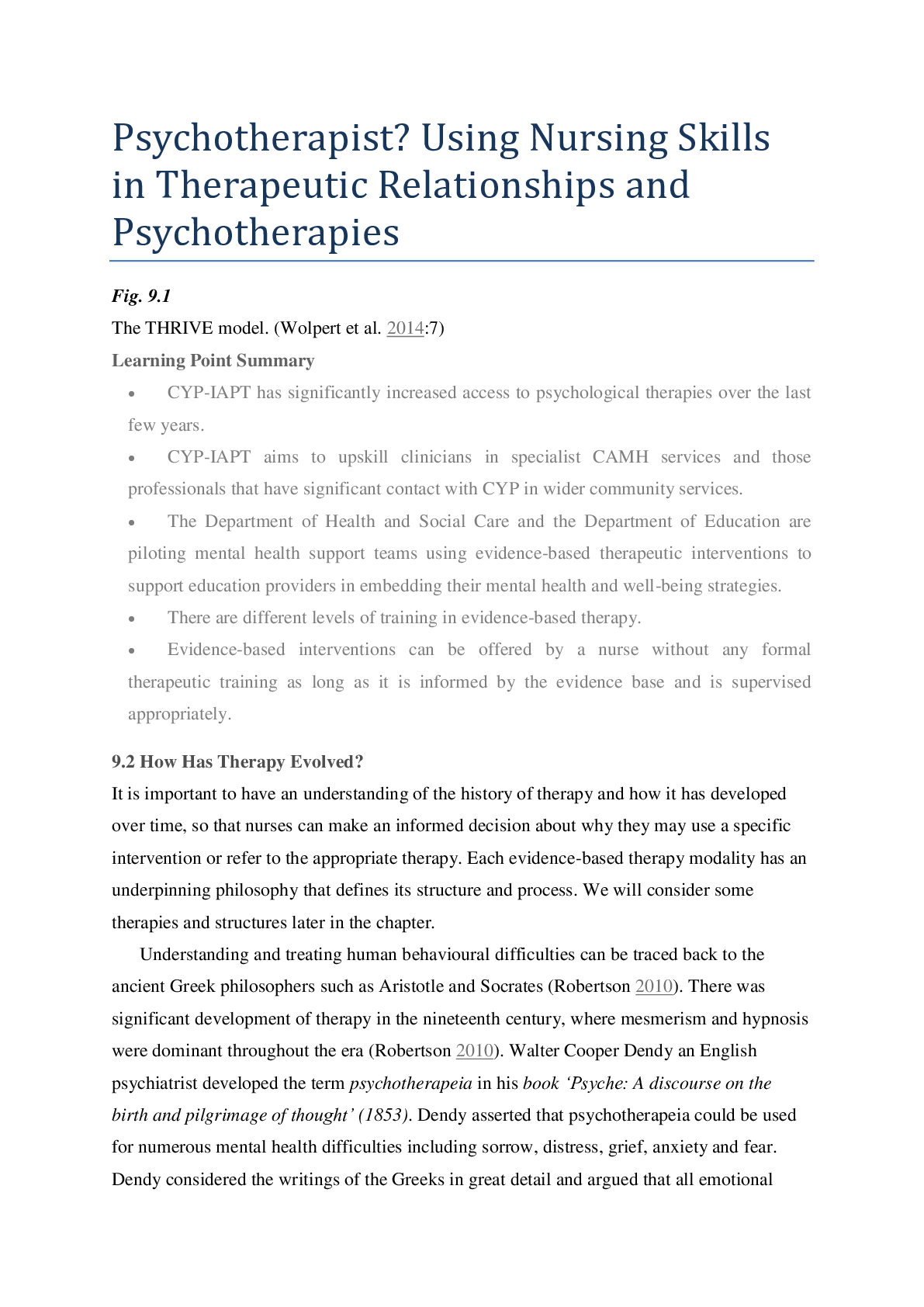
Buy this document to get the full access instantly
Instant Download Access after purchase
Add to cartInstant download
Reviews( 0 )
Document information
Connected school, study & course
About the document
Uploaded On
May 20, 2020
Number of pages
18
Written in
Additional information
This document has been written for:
Uploaded
May 20, 2020
Downloads
0
Views
56

